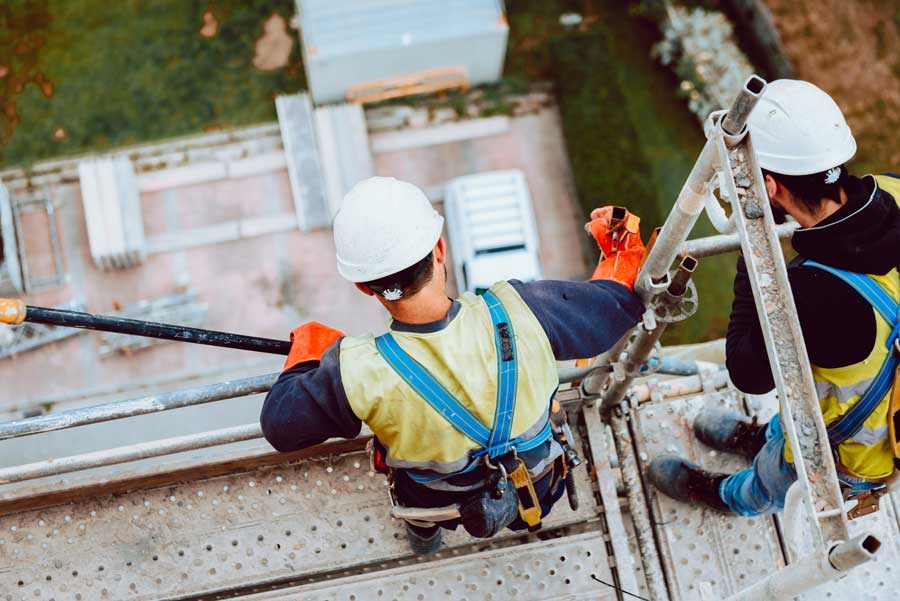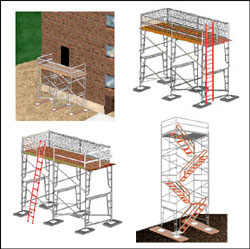
SAT 8:00AM to 12:00PM Credit ApplicationKeep in Touch


Scaffolding is a way to provide a safe and stable platform that's needed when working on an elevated surface. It offers support for concrete formwork, inclement weather, and projects that might potentially be unsafe to work on without assistance. Depending on what you need, though, there are varying degrees of scaffolds available for different circumstances - temporary vs. permanent worksites or jobs, high risk vs. low-risk buildings.
Scaffolding is usually used on buildings with heights of 16 feet and above, but you can use some for lower projects - it just simply depends on the user, contractors, and type of scaffolding. For temporary worksites, a scaffold is normally used when the work is to be done for a short time or refurbishing or renovating an existing part of the building. Short term projects are more likely done on a modular platform, while permanent worksites usually use steel frames with guardrails.
Scaffolding is used in building work for all sorts of reasons. In most cases, it's needed to elevate forms/workers above the rest of the structure to perform their duties safely and correctly. Other times it's used to cover or protect workers from inclement weather like rain or snow. You can also use scaffolding to provide a stable platform for concrete formwork so that a structure is properly secure and safe for workers.
The moment a building project is started, a scaffold is built to provide the best possible conditions for workers. It's a safety measure that aims to minimize the risk of injury or death on the job site. In modern times, working at heights is inevitable in many work settings. The use of scaffolding at construction sites and accessible buildings protects workers by minimizing their risk of falling. Using scaffolding on these projects also minimizes the risk of site workers' injury due to accidental slips or falls.
A scaffold's main role in structural building work is to provide elevated platforms that help workers safely transport materials, place formwork, and complete their daily tasks safely.
The building industry has different uses for scaffolding. There are various types of scaffolds you can use depending on your projects' needs. Temporary and permanent scaffolds are just some of the many types that can be used in different situations. A typical scaffold is made from steel. It can also be made from other materials, like wood, plastics, or aluminum. Temporary worksites normally use temporary scaffolds, and this type of scaffold is usually made with a lightweight material like PVC that won't become brittle in cold weather.
If you need scaffolding, call Pro Star Rental. Odds are we have what you need. And with our convenient locations around Texas, stopping by one of our stores should be a breeze!
By Pro Star Rental 8-11-2021

Pro Star Rental Texas Rents several types of scaffolding. We have provided this safety checklist for your convenience. This list is provided by the University of Oklahoma.
If you have any questions about the safe use of scaffolds, please contact EHS, X7241.
By Pro Star Rental 8-11-2021
Recent:
Categories
Archive
Jun 2025
May 2025
Apr 2025
Jan 2025
Dec 2024
Nov 2024
Oct 2024
Sep 2024
Aug 2024
Jul 2024
Jun 2024
May 2024
Apr 2024
Mar 2024
Feb 2024
Jan 2024
Dec 2023
Nov 2023
Oct 2023
Sep 2023
Aug 2023
Jul 2023
Jun 2023
Mar 2023
Feb 2023
Jan 2023
Dec 2022
Nov 2022
Oct 2022
Sep 2022
Jul 2022
Jun 2022
Apr 2022
Mar 2022
Feb 2022
Jan 2022
Dec 2021
Oct 2021
Sep 2021
Aug 2021
Jul 2021
Jun 2021
May 2021
Apr 2021
Mar 2021
Feb 2021
Jan 2021
Dec 2020
Nov 2020
Oct 2020
Sep 2020
Aug 2020
Jul 2020
Jun 2020
May 2020
Apr 2020
Mar 2020
Feb 2020
Jan 2020
Dec 2019
Oct 2019
Aug 2019
Jun 2019
Apr 2019
Mar 2019
Feb 2019
Dec 2018
Apr 2018
Nov 2017
May 2016

Enter your information below to begin receiving emails from Pro Star Rental